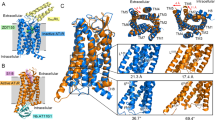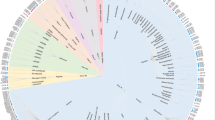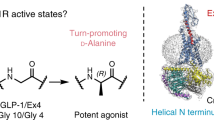Abstract
G-protein-coupled receptors (GPCRs) are the most important signal transducers in higher eukaryotes. Despite considerable progress, the molecular basis of subtype-specific ligand selectivity, especially for peptide receptors, remains unknown. Here, by integrating DNP-enhanced solid-state NMR spectroscopy with advanced molecular modeling and docking, the mechanism of the subtype selectivity of human bradykinin receptors for their peptide agonists has been resolved. The conserved middle segments of the bound peptides show distinct conformations that result in different presentations of their N and C termini toward their receptors. Analysis of the peptide–receptor interfaces reveals that the charged N-terminal residues of the peptides are mainly selected through electrostatic interactions, whereas the C-terminal segments are recognized via both conformations and interactions. The detailed molecular picture obtained by this approach opens a new gateway for exploring the complex conformational and chemical space of peptides and peptide analogs for designing GPCR subtype-selective biochemical tools and drugs.
This is a preview of subscription content, access via your institution
Access options
Access Nature and 54 other Nature Portfolio journals
Get Nature+, our best-value online-access subscription
$29.99 / 30 days
cancel any time
Subscribe to this journal
Receive 12 print issues and online access
$259.00 per year
only $21.58 per issue
Buy this article
- Purchase on Springer Link
- Instant access to full article PDF
Prices may be subject to local taxes which are calculated during checkout






Similar content being viewed by others
References
Kobilka, B.K. G protein coupled receptor structure and activation. Biochim. Biophys. Acta 1768, 794–807 (2007).
Rasmussen, S.G.F. et al. Crystal structure of the β2 adrenergic receptor-Gs protein complex. Nature 477, 549–555 (2011).
Rasmussen, S.G.F. et al. Structure of a nanobody-stabilized active state of the β2 adrenoceptor. Nature 469, 175–180 (2011).
White, J.F. et al. Structure of the agonist-bound neurotensin receptor. Nature 490, 508–513 (2012).
Isogai, S. et al. Backbone NMR reveals allosteric signal transduction networks in the β1-adrenergic receptor. Nature 530, 237–241 (2016).
Nygaard, R. et al. The dynamic process of β2-adrenergic receptor activation. Cell 152, 532–542 (2013).
Liu, J.J., Horst, R., Katritch, V., Stevens, R.C. & Wüthrich, K. Biased signaling pathways in β2-adrenergic receptor characterized by 19F-NMR. Science 335, 1106–1110 (2012).
Berkamp, S. et al. Structure of monomeric interleukin-8 and its interactions with the N-terminal binding site-I of CXCR1 by solution NMR spectroscopy. J. Biomol. NMR 69, 111–121 (2017).
Kaiser, A. et al. Unwinding of the C-terminal residues of neuropeptide Y is critical for Y2 receptor binding and activation. Angew. Chem. Int. Ed. Engl. 54, 7446–7449 (2015).
Lopez, J.J. et al. The structure of the neuropeptide bradykinin bound to the human G-protein coupled receptor bradykinin B2 as determined by solid-state NMR spectroscopy. Angew. Chem. Int. Ed. Engl. 47, 1668–1671 (2008).
Luca, S. et al. The conformation of neurotensin bound to its G protein-coupled receptor. Proc. Natl. Acad. Sci. USA 100, 10706–10711 (2003).
O'Connor, C. et al. NMR structure and dynamics of the agonist dynorphin peptide bound to the human kappa opioid receptor. Proc. Natl. Acad. Sci. USA 112, 11852–11857 (2015).
Leeb-Lundberg, L.M., Marceau, F., Müller-Esterl, W., Pettibone, D.J. & Zuraw, B.L. International union of pharmacology. XLV. Classification of the kinin receptor family: from molecular mechanisms to pathophysiological consequences. Pharmacol. Rev. 57, 27–77 (2005).
Surgand, J.-S., Rodrigo, J., Kellenberger, E. & Rognan, D. A chemogenomic analysis of the transmembrane binding cavity of human G-protein-coupled receptors. Proteins 62, 509–538 (2006).
Yin, J. et al. Structure and ligand-binding mechanism of the human OX1 and OX2 orexin receptors. Nat. Struct. Mol. Biol. 23, 293–299 (2016).
Thal, D.M. et al. Crystal structures of the M1 and M4 muscarinic acetylcholine receptors. Nature 531, 335–340 (2016).
Hillmeister, P. & Persson, P.B. The Kallikrein-Kinin system. Acta Physiol. (Oxf.) 206, 215–219 (2012).
Hess, J.F., Borkowski, J.A., Young, G.S., Strader, C.D. & Ransom, R.W. Cloning and pharmacological characterization of a human bradykinin (BK-2) receptor. Biochem. Biophys. Res. Commun. 184, 260–268 (1992).
Menke, J.G. et al. Expression cloning of a human B1 bradykinin receptor. J. Biol. Chem. 269, 21583–21586 (1994).
Becker-Baldus, J. et al. Enlightening the photoactive site of channelrhodopsin-2 by DNP-enhanced solid-state NMR spectroscopy. Proc. Natl. Acad. Sci. USA 112, 9896–9901 (2015).
Mak-Jurkauskas, M.L. et al. Energy transformations early in the bacteriorhodopsin photocycle revealed by DNP-enhanced solid-state NMR. Proc. Natl. Acad. Sci. USA 105, 883–888 (2008).
Maciejko, J. et al. Visualizing specific cross-protomer interactions in the homo-oligomeric membrane protein proteorhodopsin by dynamic-nuclear-polarization-enhanced solid-state NMR. J. Am. Chem. Soc. 137, 9032–9043 (2015).
Lehnert, E. et al. Antigenic peptide recognition on the human ABC transporter TAP resolved by DNP-enhanced solid-state NMR Spectroscopy. J. Am. Chem. Soc. 138, 13967–13974 (2016).
Kaplan, M. et al. Probing a cell-embedded megadalton protein complex by DNP-supported solid-state NMR. Nat. Methods 12, 649–652 (2015).
Jacso, T. et al. Characterization of membrane proteins in isolated native cellular membranes by dynamic nuclear polarization solid-state NMR spectroscopy without purification and reconstitution. Angew. Chem. Int. Ed. Engl. 51, 432–435 (2012).
Frederick, K.K. et al. Sensitivity-enhanced NMR reveals alterations in protein structure by cellular milieus. Cell 163, 620–628 (2015).
Raveh, B., London, N., Zimmerman, L. & Schueler-Furman, O. Rosetta FlexPepDock ab-initio: simultaneous folding, docking and refinement of peptides onto their receptors. PLoS One 6, e18934 (2011).
Fathy, D.B., Kyle, D.J. & Leeb-Lundberg, L.M. High-affinity binding of peptide agonists to the human B1 bradykinin receptor depends on interaction between the peptide N-terminal L-lysine and the fourth extracellular domain of the receptor. Mol. Pharmacol. 57, 171–179 (2000).
Fathy, D.B., Mathis, S.A., Leeb, T. & Leeb-Lundberg, L.M. A single position in the third transmembrane domains of the human B1 and B2 bradykinin receptors is adjacent to and discriminates between the C-terminal residues of subtype-selective ligands. J. Biol. Chem. 273, 12210–12218 (1998).
Ha, S.N. et al. Identification of the critical residues of bradykinin receptor B1 for interaction with the kinins guided by site-directed mutagenesis and molecular modeling. Biochemistry 45, 14355–14361 (2006).
Jarnagin, K. et al. Mutations in the B2 bradykinin receptor reveal a different pattern of contacts for peptidic agonists and peptidic antagonists. J. Biol. Chem. 271, 28277–28286 (1996).
Kyle, D.J. Structural features of the bradykinin receptor as determined by computer simulations, mutagenesis experiments, and conformationally constrained ligands: establishing the framework for the design of new antagonists. Braz. J. Med. Biol. Res. 27, 1757–1779 (1994).
Gieldon, A., Lopez, J.J., Glaubitz, C. & Schwalbe, H. Theoretical study of the human bradykinin-bradykinin B2 receptor complex. ChemBioChem 9, 2487–2497 (2008).
Regoli, D., Rizzi, A., Perron, S.I. & Gobeil, F. Jr. Classification of kinin receptors. Biol. Chem. 382, 31–35 (2001).
Leeb-Lundberg, L.M., Kang, D.S., Lamb, M.E. & Fathy, D.B. The human B1 bradykinin receptor exhibits high ligand-independent, constitutive activity. Roles of residues in the fourth intracellular and third transmembrane domains. J. Biol. Chem. 276, 8785–8792 (2001).
Granier, S. et al. Structure of the δ-opioid receptor bound to naltrindole. Nature 485, 400–404 (2012).
Shihoya, W. et al. Activation mechanism of endothelin ETB receptor by endothelin-1. Nature 537, 363–368 (2016).
Hong, M. Solid-state dipolar INADEQUATE NMR spectroscopy with a large double-quantum spectral width. J. Magn. Reson. 136, 86–91 (1999).
Hohwy, M., Jakobsen, H.J., Eden, M., Levitt, M.H. & Nielsen, N.C. Broadband dipolar recoupling in the nuclear magnetic resonance of rotating solids: A compensated C7 pulse sequence. J. Chem. Phys. 108, 2686–2694 (1998).
Jaroniec, C.P., Filip, C. & Griffin, R.G. 3D TEDOR NMR experiments for the simultaneous measurement of multiple carbon-nitrogen distances in uniformly (13)C,(15)N-labeled solids. J. Am. Chem. Soc. 124, 10728–10742 (2002).
Fung, B.M., Khitrin, A.K. & Ermolaev, K. An improved broadband decoupling sequence for liquid crystals and solids. J. Magn. Reson. 142, 97–101 (2000).
Shen, Y., Delaglio, F., Cornilescu, G. & Bax, A. TALOS+: a hybrid method for predicting protein backbone torsion angles from NMR chemical shifts. J. Biomol. NMR 44, 213–223 (2009).
Shen, Y. & Bax, A. Protein backbone and sidechain torsion angles predicted from NMR chemical shifts using artificial neural networks. J. Biomol. NMR 56, 227–241 (2013).
Berjanskii, M.V., Neal, S. & Wishart, D.S. PREDITOR: a web server for predicting protein torsion angle restraints. Nucleic Acids Res. 34, W63–W69 (2006).
Güntert, P., Mumenthaler, C. & Wüthrich, K. Torsion angle dynamics for NMR structure calculation with the new program DYANA. J. Mol. Biol. 273, 283–298 (1997).
Doreleijers, J.F. et al. CING: an integrated residue-based structure validation program suite. J. Biomol. NMR 54, 267–283 (2012).
Ozenne, V. et al. Flexible-meccano: a tool for the generation of explicit ensemble descriptions of intrinsically disordered proteins and their associated experimental observables. Bioinformatics 28, 1463–1470 (2012).
Neal, S., Nip, A.M., Zhang, H. & Wishart, D.S. Rapid and accurate calculation of protein 1H, 13C and 15N chemical shifts. J. Biomol. NMR 26, 215–240 (2003).
Brünger, A.T. et al. Crystallography & NMR system: A new software suite for macromolecular structure determination. Acta Crystallogr. D Biol. Crystallogr. 54, 905–921 (1998).
Linge, J.P., O'Donoghue, S.I. & Nilges, M. Automated assignment of ambiguous nuclear overhauser effects with ARIA. Methods Enzymol. 339, 71–90 (2001).
Leaver-Fay, A. et al. ROSETTA3: an object-oriented software suite for the simulation and design of macromolecules. Methods Enzymol. 487, 545–574 (2011).
Konagurthu, A.S., Whisstock, J.C., Stuckey, P.J. & Lesk, A.M. MUSTANG: a multiple structural alignment algorithm. Proteins 64, 559–574 (2006).
Larkin, M.A. et al. Clustal W and Clustal X version 2.0. Bioinformatics 23, 2947–2948 (2007).
Jones, D.T. Protein secondary structure prediction based on position-specific scoring matrices. J. Mol. Biol. 292, 195–202 (1999).
Viklund, H. & Elofsson, A. OCTOPUS: improving topology prediction by two-track ANN-based preference scores and an extended topological grammar. Bioinformatics 24, 1662–1668 (2008).
Song, Y. et al. High-resolution comparative modeling with RosettaCM. Structure 21, 1735–1742 (2013).
Bellucci, F. et al. A different molecular interaction of bradykinin and the synthetic agonist FR190997 with the human B2 receptor: evidence from mutational analysis. Br. J. Pharmacol. 140, 500–506 (2003).
Shen, Y. & Bax, A. SPARTA+: a modest improvement in empirical NMR chemical shift prediction by means of an artificial neural network. J. Biomol. NMR 48, 13–22 (2010).
Han, B., Liu, Y., Ginzinger, S.W. & Wishart, D.S. SHIFTX2: significantly improved protein chemical shift prediction. J. Biomol. NMR 50, 43–57 (2011).
Nguyen, E.D., Norn, C., Frimurer, T.M. & Meiler, J. Assessment and challenges of ligand docking into comparative models of G-protein coupled receptors. PLoS One 8, e67302 (2013).
Acknowledgements
We would like to thank T. Mosler and M. Radloff for excellent technical assistance. The German Research Foundation has supported this work through an equipment grant (GL 307/8-1). Funding by DFG project G-NMR and by SFB 807 “Transport and communication across membranes,” the Cluster of Excellence Frankfurt Macromolecular Complexes and the Max Planck Society is acknowledged. The work was also supported by BMRZ through infrastructure support by the State of Hesse. Work in the Meiler laboratory is supported through NIH (R01 GM080403, R01 GM099842 and R01 GM073151) and NSF (CHE 1305874).
Author information
Authors and Affiliations
Contributions
C.G. and H.M. conceived the project. L.J. expressed and purified B1R and performed radioactive ligand binding assays. J. Mao designed and performed DNP-ssNMR measurements, analyzed data, determined structural models of the kinin peptides and performed the analysis of B1R homolog sequences. G.K. performed molecular modeling and computational docking studies. C.R. and T.K. carried out expression of mutants and additional binding assays. H.R.A.J., C.R. and H.S. provided and analyzed supplementary liquid-state NMR data on nonbound DAKD. J.P. assisted with receptor purification and sample preparation. J. Meiler, H.M., C.G. supervised the overall project. L.J., J. Mao, G.K. and C.G. wrote the manuscript.
Corresponding authors
Ethics declarations
Competing interests
The authors declare no competing financial interests.
Supplementary information
Supplementary Text and Figures
Supplementary Tables 1–11, Supplementary Figures 1–20 (PDF 7426 kb)
Rights and permissions
About this article
Cite this article
Joedicke, L., Mao, J., Kuenze, G. et al. The molecular basis of subtype selectivity of human kinin G-protein-coupled receptors. Nat Chem Biol 14, 284–290 (2018). https://doi.org/10.1038/nchembio.2551
Received:
Accepted:
Published:
Issue Date:
DOI: https://doi.org/10.1038/nchembio.2551
This article is cited by
-
Function and structure of bradykinin receptor 2 for drug discovery
Acta Pharmacologica Sinica (2023)
-
Strategies for acquisition of resonance assignment spectra of highly dynamic membrane proteins: a GPCR case study
Journal of Biomolecular NMR (2023)
-
Computer simulation of molecular recognition in biomolecular system: from in silico screening to generalized ensembles
Biophysical Reviews (2022)
-
Molecular basis for kinin selectivity and activation of the human bradykinin receptors
Nature Structural & Molecular Biology (2021)
-
DNP-supported solid-state NMR studies of 13C,15N,29Si-enriched biosilica of Cyclotella cryptica and Thalassiosira pseudonana
Discover Materials (2021)



